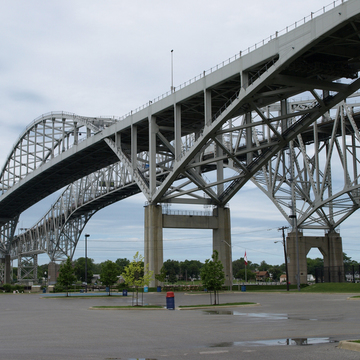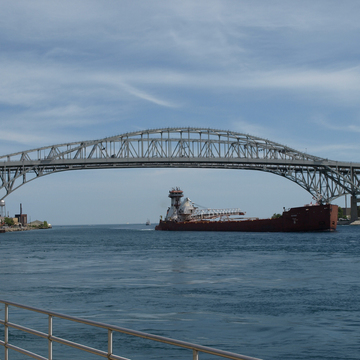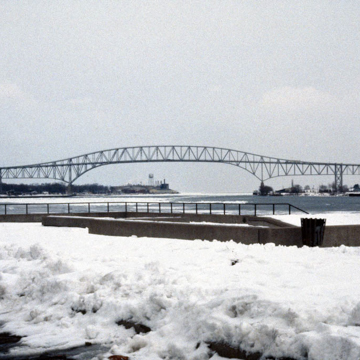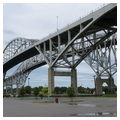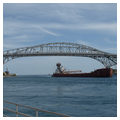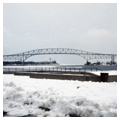You are here
Blue Water Bridge–First Span (Blue Water 1)
Connecting Port Huron and Point Edward/Sarnia, Ontario, the Blue Water Bridge consists of two three-lane spans and toll and inspection plazas on both the U.S. and Canadian borders. The northern sweeping steel cantilever span is the earlier. Before the bridge was built, ferries operated by the Port Huron Sarnia Ferry Company, established in 1881, transported people, cars, and goods across the swiftly flowing river between Port Huron and Sarnia. Plans made in 1927 to span the St. Clair River with a bridge languished during the Great Depression. In 1937 the Michigan Highway Commission and the Minister of Highways for Canada hired Ralph Modjeski and Frank H. Masters and their Canadian associates, Monsarrat and Pratley, to design the bridge. It has an overall length of 6,463 feet; the main span is 871 feet in length; the anchor arms are 326 feet long each; and approaches consisting of deck girder and deck truss spans are 2,283 feet long on the American side and 2,657 feet long on the Canadian side. Caissons sunk to rock 95 feet below water level make up the two main piers. The bridge's main span clears the heavily navigated St. Clair River by 150 feet. The Missouri Valley Bridge and Iron Works and the Kansas City Bridge Company built the piers for the main span. E. C. Nolan and Son of Detroit built the American approach piers. Russell Construction Company of Toronto built the Canadian approach piers. The American Bridge Company fabricated and erected the main span, the Wisconsin Bridge and Iron Company erected the American approaches, and the Sarnia Bridge Company built the superstructure for the Canadian approach span. A Streamline Moderne plaza, designed by Norman B. Forbes and George L. Harvey of Port Huron, graced the American side until the bridge and plaza were rehabilitated in 1997–1999.
Writing Credits
If SAH Archipedia has been useful to you, please consider supporting it.
SAH Archipedia tells the story of the United States through its buildings, landscapes, and cities. This freely available resource empowers the public with authoritative knowledge that deepens their understanding and appreciation of the built environment. But the Society of Architectural Historians, which created SAH Archipedia with University of Virginia Press, needs your support to maintain the high-caliber research, writing, photography, cartography, editing, design, and programming that make SAH Archipedia a trusted online resource available to all who value the history of place, heritage tourism, and learning.


